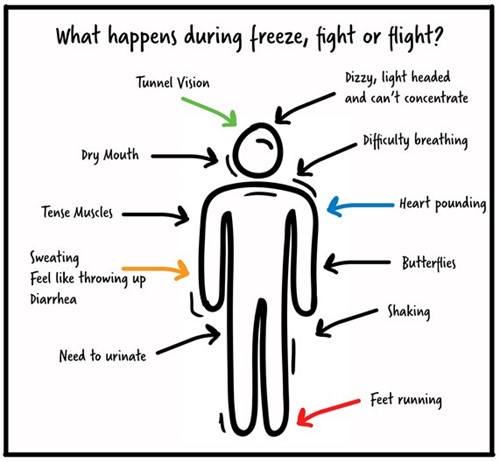Anxiety is a normal response to a difficult situation. It is an early warning signal that we need to take care. It is our body’s way of flagging up challenging and risky situations. There are times when we all feel worried, anxious and uptight or stressed. Often there is a reason for feeling anxious such as:
Once the event is over our bodies return to normal and we feel better.
Anxiety only becomes a problem when it starts to get in the way of a person enjoying normal life. It might begin to affect school work, family relationships, friendships or social life. When this happens anxiety has the upper hand, the person experiencing anxiety will need help, to learn the coping strategies that help them take back control.
In Professional Settings
For many children & young people basic ‘emotional first aid’ to understand and normalise the difficult feelings anxiety can bring will be very effective. This can help children and young people understand why their heart might race before an exam or they feel sick when they go somewhere new. This might be something you offer to a group of children or to individuals.
Help them identify an anxiety trigger - you could you this worksheet to help.
It can help to write it down/draw it out. Teenagers might write down their worries in a journal. Children could post their worries into a worry box so that it can be looked at with someone they trust.
Children can be black and white in their thinking. This can mean they only see success or catastrophe in a situation; help them to think about other possible outcomes.
Avoiding the thing or situation that provokes the anxiety is an understandable instinct. However this gives the anxiety ‘control’ rather than working through the feelings it brings and ‘proving’ that the anxiety was wrong. The person might have to build up to this in small steps with your support; reminding them the feelings will pass. Maybe they faced this problem before and need reminding they can do it again.
Relaxation Techniques
Relaxation techniques can help in moments when the anxiety level is high. Taking some deep breaths will help to calm down the physical symptoms of anxiety.
If the child or young person continues to struggle, and it is impacting on their ability to enjoy and thrive - they may need additional support and onward referral into specialist services should be considered.
Freeze, Fight or Flight?
When we become anxious our body prepares itself for some form of physical action, often called the ‘flight or flight’ reaction. This describes the physiological response to acute stress – where the body prepares to fight or flee from perceived danger.
The person will probably notice a number of physical changes including the ones below.

Resources
Charlie Waller Resources
CARE Approach
The CARE animation is a short animation for all professional settings that recognises the importance of supporting children and young people’s mental health in settings, and offers a simple principle for professionals to remember; CARE. (Curious, Approachable, Refer, Empathy). It is aimed at all professionals, including support staff and those who may not have direct contact with young people. The animation can be used in one of the following ways:
You can watch the CARE animation and download the accompanying guidance and poster at www.annafreud.org/careanimation.
E-Learning
'All Our Health' offer free, bite-sized e-learning sessions - to improve the knowledge, confidence and skills of health and care professionals in preventing illness, protecting health and promoting wellbeing. The sessions cover some of the biggest issues in public health including;
They contain signposting to trusted sources of helpful evidence, guidance and support to help professionals embed prevention in their everyday practice.
Shelf Help - Reading Well